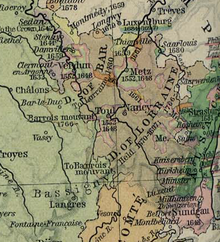Treaty of Chambord


The Treaty of Chambord ( French Traité de Chambord ) from 15. January 1552 was against Emperor Charles V directed Agreement between the Protestant Prince opposition to Maurice of Saxony and the King of France . It was signed at Chambord Castle .
After signing, France invaded the Holy Roman Empire and occupied the territories assigned to it in the treaty. After the Protestant rebellion within the empire and the arrival of their troops, France was able to win the war in 1556. The result was France's first major territorial gains to the east, which, however, could not be officially recognized until 1648. But the event had an encouraging effect on later reunion policy .
history
Moritz needed the support of the great Catholic power France because he and his Protestant allies ( Johann Albrecht von Mecklenburg-Schwerin and Landgrave Wilhelm von Hessen ) did not have enough money and, above all, armed forces to be able to take action against the emperor. The contract came about through the mediation of Margrave Albrecht Alcibiades von Brandenburg-Kulmbach . In return for the support through large monetary payments, the French king was guaranteed the imperial vicariate over the imperial cities (and in fact also the border bishoprics ) of Toul , Verdun , Metz and Cambrai in Lorraine .
This treaty was the decisive prerequisite for the prince uprising in the spring of 1552 under the leadership of Moritz, which was concluded in August 1552 with the Passau Treaty , in which Protestantism found its formal recognition.
Since Emperor Karl could not recognize the Treaty of Chambord and its agreements, he took up the war with France in 1552 for Metz, Toul, Cambrai and Verdun, but was unable to assert himself militarily against France until 1556. His successor, Emperor Ferdinand I , stopped the war so that the cities remained under French control.
- King of France
- Signatories of the treaty, Lutheran princes of the empire
Effects
The Chambord Treaty was a typical third party contract . The imperial princes acting on the German side had given France a promise to which they had neither power nor authorization. They ceded rights over the imperial territory to a foreign ruler to which they were not entitled. The contract was therefore irrelevant by legal standards. Regardless of the dubious legal nature of this treaty and taking advantage of the emperor's current weakness, France used this agreement as a pretext to occupy the affected cities militarily and later to separate them completely from the association of the Holy Roman Empire and to incorporate them into their own territory. In the Peace of Westphalia of 1648, the three cities were officially ceded to France.
The actions of the French crown arose from a fundamental, strategic conflict, the Franco-Habsburg conflict, which lasted from the end of the 15th to the middle of the 18th century. In order to free their country from the clutches of Habsburg territories, the kings of France repeatedly used conflicts within Germany between the imperial princes and the emperor to weaken the latter by supporting his opponents.
Extract from the contract
“We see before our eyes the ruse by which our adversaries believe that our religion is to be restricted and, in the end, even to be eradicated. We saw how the Roman Kaiserl. Your Majesty seeks not only the electors and princes, but also the counts, lords, the rest of the nobility, the honorable cities and common subjects of our beloved fatherland, the German nation, from their old freedoms to such a beastly, unbearable and eternal bondage like Spain wants to bring [...] ”.
“So we considered that we would rather face hardship and death, because to be submissive to such a shame for a longer period of time, and to get our will done, we confidently entered into an understanding with Mr. Heinrich, King of France, so that we want to Throw the arduous yoke of bondage from me with army force and save the old freedom of our beloved fatherland, the German nation […] ”.
“In order to preserve the war people, the king willingly will and should hand us over every month and shoot 70,000 gold crowns. No more should be ranked as a supreme captain of the field [...] For this purpose, the elector of Saxony [...] was elected colonel general by the rest of us. It is also considered good that the royal. Your Majesty to France immediately took over the cities that belonged to the empire from time immemorial and are not German, namely Cambrai, Toul, Metz and Verdun, without delay and which I hold and retain as vicar of the empire. "
Text output
- Treaty of Chambord. In: Letters and files on the history of the sixteenth century with special regard to Bavaria's Princely House. Published by the Historical Commission at the Royal Academy of Sciences on the initiative and with the support of His Majesty the King of Bavaria. 6 vol., Munich 1873–1913, vol. 3, Munich 1882: Contributions to the history of the empire 1546–1552. Edited by August von Druffel. No. 902, pp. 340-350 ( digitized version in the Internet Archive ).
literature
- Hermann Weber : Le traité de Chambord (1552). In: Charles-Quint, le Rhin et la France. Droit savant et droit pénal à l'époque de Charles-Quint. Actes des journées d'études de Strasbourg (2-3 March 1973). Istra, Strasbourg 1973, ( Publications de la Société savante d'Alsace et des régions de l'est - Collection “Recherches et documents” 17, ZDB -ID 416540-8 ), pp. 81-94.
- Rainer Babel : Germany and France under the sign of the Habsburg universal monarchy, 1500–1648. (= WBG German-French History. Vol. 3). Wissenschaftliche Buchgesellschaft, Darmstadt 2005, ISBN 3-534-14701-4 , chapter The conceptions of the French imperial politics and the Treaty of Chambord. Pp. 47-51.
Coordinates: 47 ° 36 ′ 57.5 ″ N , 1 ° 31 ′ 2 ″ E




